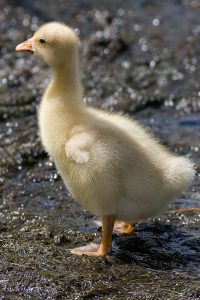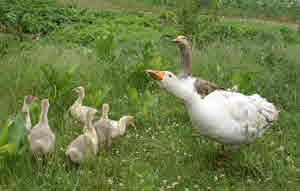
Courtesy of Wikipedia
Breeding Geese
As with other poultry if you wish to hatch out goslings you can either allow a broody goose to sit on a clutch or incubate the eggs. Another option is to use a broody chicken to sit the eggs and they will raise the chicks as they would their own although you will have to encourage the chicks to water if you choose this option.
Geese will go broody especially if you leave a number of eggs in the nesting area. If you want to prevent a broody goose you should remove the eggs daily and once the geese have laid close off the nesting areas to dissuade the goose from the behaviour.
Incubating Goose Eggs
The sitting or incubation period for geese is between 28-32 days and the temperature on an incubator should be set at between 37.2-38.4oC depending on your manufacturers recommendation. You should sit the eggs for 24 hours before incubating with pointy end down and allow them to settle at room temperature for this period and try to avoid using eggs that are older than 7 days.
You should candle the eggs at 7 days and then again at 21 days to check the development of the embryo and dispose of any eggs that are blown or infertile at this point. Do not move the eggs from the broody or incubator except for turning after 21 days to ensure an optimum hatch rate.
Eggs should be turned at least 3 times a day. A broody will do this for you and most incubators have automatic turners but if you have a manual turn incubator make a note of your turnings and make sure you do keep to at least 3 turns a day (a broody will turn as often as every hour) and each time in the opposite direction to the time before.

Brooding Goslings
Once the goslings have hatched a broody will take them to food and water (if a goose hen) but if being raised by a chicken you will need after day three to guide the goslings to water. This should be very shallow so that the goslings cannot drown in the water.
If keeping goslings in a brooder you should maintain a temperature of 38°C and then you should reduce the temperature by 1 degree each week for six weeks and then by 2 degrees to outdoor temperature before moving them outside.
Goslings should be fed on a starter ration for the first 3-4 weeks and them moved onto growing mash or pellets and start to incorporate wheat and grain into their diets until they reach 14 weeks of age.
Breeds of Geese
Generally speaking, most of the commercial breed strains have been developed from one or more of the following: Embden, Chinese and Toulouse. The Chinese gives a higher egg production rate, while the Toulouse provides increased body weight. The Embden contributes a good body weight as well as white feathers. Most producers of table geese in Britain prefer white-feathered birds to grey-feathered ones.
The domestic breeds are also divided into heavy, medium and light classifications.
Geese for Meat
Geese for Egg Production
Whilst goose eggs are a gourmet item and excellent in many dishes the low rate of production means that they are not economically viable purely for eggs unlike hens or ducks. Most breeds only lay between 10 and 20 eggs in a season, the Roman and Sebastopols will lay 30 but most productive are the Chinese at around 40 to 80 eggs per annum depending on the strain.
Further Articles All About Geese
- Breeds of Geese & Breeding Geese
- Geese Diseases, Parasites, Worms, Lice & Mites
- Housing Geese, Pasture, and Safety
- Introduction to Geese & Feeding Geese
- Rearing Geese for the Table from Starting with Geese

